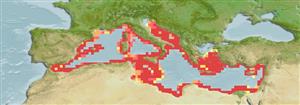Cephalopoda |
Sepiida |
Sepiolidae | Sepiolinae
Environment: milieu / climate zone / depth range / distribution range
Ecology
Benthic; depth range 26 - 498 m (Ref. 1695). Subtropical; 46°N - 30°N, 6°W - 37°E (Ref. 1695)
Endemic to the Mediterranean Sea.
Length at first maturity / Size / Weight / Age
Maturity: Lm ? range ? - ? cm Max length : 2.5 cm ML male/unsexed; (Ref. 1695); 2.8 cm ML (female)
Found along the outer shelf between 26 and 498 m depth. Mating takes place when the male grasps the female's 'neck' region, and spermatophores are placed in the female's bursa copulatrix. Males have been observed to guard females during courtship. Contributes (although in low numbers) to the local trawl fishery as one of the most frequently captured Mediterranean species of this genus (Ref. 1695).
Life cycle and mating behavior
Maturity | Reproduction | Spawning | Eggs | Fecundity | Larvae
Members of the class Cephalopoda are gonochoric. Male and female adults usually die shortly after spawning and brooding, respectively. Mating behavior: Males perform various displays to attract potential females for copulation. During copulation, male grasp the female and inserts the hectocotylus into the female's mantle cavity where fertilization usually occurs. Life cycle: Embryos hatch into planktonic stage and live for some time before they grow larger and take up a benthic existence as adults.
Jereb, P. and C.F.E. Roper (eds.) 2005 Cephalopods of the world. An Annotated and Illustrated catalogue of Cephalopod species known to date. Vol. 1. Chambered nautiluses and sepioids (Nautilidae, Sepiidae, Sepiolidae, Sepiadariidae, Idiosepiidae and Spirulidae). FAO Spec. Cat. Fish. Purp. 4(1):262p. Rome: FAO. (Ref. 1695)
IUCN Red List Status
(Ref. 130435: Version 2025-1)
CITES status (Ref. 108899)
Not Evaluated
Not Evaluated
Threat to humans
Human uses
| FishSource |
Tools
More information
Population dynamicsGrowthMax. ages / sizesLength-weight rel.Length-length rel.Length-frequenciesMass conversionAbundance Life cycleReproductionMaturityFecunditySpawningEggsEgg developmentLarvae PhysiologyOxygen consumption
Human RelatedStamps, coins, misc.
Internet sources
Estimates based on models
Preferred temperature
(Ref.
115969): 13.2 - 16.1, mean 14.8 (based on 124 cells).
Fishing Vulnerability
Low vulnerability (10 of 100).
Price category
Unknown.
